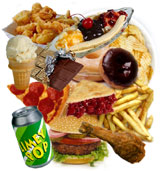A Growing Problem
What causes childhood obesity?
Childhood obesity is the result of eating too many calories and not getting enough physical activity.
Why focus on food and physical activity environments?
There are a variety of environmental factors that determine whether or not the healthy choice is the easy choice for children and their parents. American society has become characterized by environments that promote increased consumption of less healthy food and physical inactivity. It can be difficult for children to make healthy food choices and get enough physical activity when they are exposed to environments in their home, child care center, school, or community that are influenced by–
 Sugar drinks and less healthy foods on school campuses. About 55 million school-aged children are enrolled in schools across the United States,1 and many eat and drink meals and snacks there. Yet, more than half of U.S. middle and high schools still offer sugar drinks and less healthy foods for purchase.2 Students have access to sugar drinks and less healthy foods at school throughout the day from vending machines and school canteens and at fundraising events, school parties, and sporting events.
Sugar drinks and less healthy foods on school campuses. About 55 million school-aged children are enrolled in schools across the United States,1 and many eat and drink meals and snacks there. Yet, more than half of U.S. middle and high schools still offer sugar drinks and less healthy foods for purchase.2 Students have access to sugar drinks and less healthy foods at school throughout the day from vending machines and school canteens and at fundraising events, school parties, and sporting events.- Advertising of less healthy foods. Nearly half of U.S. middle and high schools allow advertising of less healthy foods,2 which impacts students' ability to make healthy food choices. In addition, foods high in total calories, sugars, salt, and fat, and low in nutrients are highly advertised and marketed through media targeted to children and adolescents,3 while advertising for healthier foods is almost nonexistent in comparison.
- Variation in licensure regulations among child care centers. More than 12 million children regularly spend time in child care arrangements outside the home.4 However, not all states use licensing regulations to ensure that child care facilities encourage more healthful eating and physical activity.5
-
 Lack of daily, quality physical activity in all schools. Most adolescents fall short of the 2008 Physical Activity Guidelines for Americans recommendation of at least 60 minutes of aerobic physical activity each day, as only 18% of students in grades 9—12 met this recommendation in 2007.6 Daily, quality physical education in school can help students meet the Guidelines. However, in 2009 only 33% attended daily physical education classes.7
Lack of daily, quality physical activity in all schools. Most adolescents fall short of the 2008 Physical Activity Guidelines for Americans recommendation of at least 60 minutes of aerobic physical activity each day, as only 18% of students in grades 9—12 met this recommendation in 2007.6 Daily, quality physical education in school can help students meet the Guidelines. However, in 2009 only 33% attended daily physical education classes.7 - No safe and appealing place, in many communities, to play or be active. Many communities are built in ways that make it difficult or unsafe to be physically active. For some families, getting to parks and recreation centers may be difficult, and public transportation may not be available. For many children, safe routes for walking or biking to school or play may not exist. Half of the children in the United States do not have a park, community center, and sidewalk in their neighborhood. Only 27 states have policies directing community-scale design.8
 Limited access to healthy affordable foods. Some people have less access to stores and supermarkets that sell healthy, affordable food such as fruits and vegetables, especially in rural, minority, and lower-income neighborhoods.9 Supermarket access is associated with a reduced risk for obesity.9 Choosing healthy foods is difficult for parents who live in areas with an overabundance of food retailers that tend to sell less healthy food, such as convenience stores and fast food restaurants.
Limited access to healthy affordable foods. Some people have less access to stores and supermarkets that sell healthy, affordable food such as fruits and vegetables, especially in rural, minority, and lower-income neighborhoods.9 Supermarket access is associated with a reduced risk for obesity.9 Choosing healthy foods is difficult for parents who live in areas with an overabundance of food retailers that tend to sell less healthy food, such as convenience stores and fast food restaurants.- Greater availability of high-energy-dense foods and sugar drinks. High-energy-dense foods are ones that have a lot of calories in each bite. A recent study among children showed that a high-energy-dense diet is associated with a higher risk for excess body fat during childhood.10,11 Sugar drinks are the largest source of added sugar and an important contributor of calories in the diets of children in the United States.12 High consumption of sugar drinks, which have few, if any, nutrients, has been associated with obesity.13 On a typical day, 80% of youth drink sugar drinks.14
- Increasing portion sizes. Portion sizes of less healthy foods and beverages have increased over time in restaurants, grocery stores, and vending machines. Research shows that children eat more without realizing it if they are served larger portions.15,16 This can mean they are consuming a lot of extra calories, especially when eating high-calorie foods.
- Lack of breastfeeding support. Breastfeeding protects against childhood overweight and obesity.17,18 However, in the United States, while 75% of mothers start out breastfeeding, only 13% of babies are exclusively breastfed at the end of 6 months. The success rate among mothers who want to breastfeed can be improved through active support from their families, friends, communities, clinicians, health care leaders, employers, and policymakers.
-
 Television and media. Children 8—18 years of age spend an average of 7.5 hours a day using entertainment media, including TV, computers, video games, cell phones, and movies. Of those 7.5 hours, about 4.5 hours is dedicated to viewing TV.19 Eighty-three percent of children from 6 months to less than 6 years of age view TV or videos about 1 hour and 57 minutes a day.20 TV viewing is a contributing factor to childhood obesity because it may take away from the time children spend in physical activities; lead to increased energy intake through snacking and eating meals in front of the TV; and, influence children to make unhealthy food choices through exposure to food advertisements.21,22
Television and media. Children 8—18 years of age spend an average of 7.5 hours a day using entertainment media, including TV, computers, video games, cell phones, and movies. Of those 7.5 hours, about 4.5 hours is dedicated to viewing TV.19 Eighty-three percent of children from 6 months to less than 6 years of age view TV or videos about 1 hour and 57 minutes a day.20 TV viewing is a contributing factor to childhood obesity because it may take away from the time children spend in physical activities; lead to increased energy intake through snacking and eating meals in front of the TV; and, influence children to make unhealthy food choices through exposure to food advertisements.21,22
References
- Snyder TD, Dillow SA, Hoffman CM. Digest 81. of education statistics 2008. Washington (DC): U.S. Department of Education, Institute of Education Sciences, National Center for Education Statistics; 2009. NCES publication number 2009—020.
- Centers for Disease Control and Prevention. Children's Food Environment State Indicator Report, 2011.
- Institute of Medicine, Food Marketing to Children and Youth: Threat or Opportunity? Washington, DC, National Academies Press; 2005.
- Pathways and Partnerships for Childcare Excellence. Available at http://www.acf.hhs.gov/programs/ccb/ta/pubs/pathways/pathways_partnerships_v1.pdf [PDF-250k].
- Kaphingst, KM, and Story M. Child care as an untapped setting for obesity prevention: state child care licensing regulations related to nutrition, physical activity, and media use for preschool-aged children in the united states. Preventing Chronic Disease: Public Research, Practice and Policy 2009l 6(1):1—13.Available at www.cdc.gov/pcd/issues/2009/jan/07_0240.htm
- U.S. Department of Health and Human 2. Services. 2008 Physical Activity Guidelines for Americans. Washington (DC): U.S. Department of Health and Human Services; 2008.
- Youth Risk Behavior Surveillance System. 3. 2009 National YRBS Overview. Available at http://www.cdc.gov/HealthyYouth/yrbs/pdf/us_physical_trend_yrbs.pdf [PDF-91k]. Accessed June 9, 2010.
- Centers for Disease Control and Prevention. State Indicator Report on Physical Activity, 2010. Available at http://www.cdc.gov/physicalactivity/downloads/PA_State_Indicator_Report_2010.pdf [PDF-1.5Mb].
- Larson N, Story M, Nelson M. Neighborhood environments: disparities in access to healthy foods in the U.S. Am J Prev Med. 2009;36(1):74—81.e10.
- Johnson L, Mander AP, Jones LR, Emmett 28. PM, Jebb SA. A prospective analysis of dietary energy density at age 5 and 7 years and fatness at 9 years among UK children. Int J Obes (Lond) 2008;32(4):586—593.
- Johnson L, Mander AP, Jones LR, Emmett 29. PM, Jebb SA. Energy-dense, low-fiber, high-fat dietary pattern is associated with increased fatness in childhood. Am J Clin Nutr 2008;87:846—854.
- Reedy J, Krebs-Smith SM. Dietary sources of energy, solid fats, and added sugars among children and adolescents in the United States. J Am Diet Assoc 2010;110(10):1477—84.
- Vartanian LR, Schwartz MB, Brownell KD. Effects of soft drink consumption on nutrition and health: a systematic review and meta-analysis. Am J Public Health 2007;97(4):667—675.
- Wang YC, Bleich SN, Gortmaker SL. 5. Increasing caloric contribution from sugar-sweetened beverages and 100% fruit juices among US children and adolescents, 1988–2004. Pediatrics 2008;121(6):e1604—1614.
- Fisher JO, Rolls BJ, Birch LL. Children's bite size and intake of an entrée are greater with large portions than with age-appropriate or self-selected portions. Amer J Clin Nutr 2003;77(5):1164—1170.
- McConahy KL, Smiciklas-Wright H, Mitchell DC, Picciano MF. Portion size of common foods predicts energy intake among preschool-aged children. J Amer Diet Assoc 2004;104(6):975—979.
- Arenz S, Ruckerl R, Koletzko B, von Kries R. Breast-feeding and childhood obesity – a systematic review. Int J Obes Relat Metab Disord 2004; 28:1247—1256.
- Owen CG, Martin RM, Whincup PH, et al. Effect of infant feeding on the risk of obesity across the life course: a quantitative review of published evidence. Pediatrics 2005; 115:1367—1377.
- Rideout VJ, Foehr UG, Roberts DF. Generation of M2 Media in the Lives of 8-18 Year Olds. A Kaiser Family Foundation Study; 2010.
- Rideout V & Hamil E. (2006). The Media Family: Electronic Media in the Lives of Infants, Toddlers, Preschoolers, and Their Parents. Menlo Park, CA: The Henry J. Kaiser Family Foundation; 2006.
- Zimmerman FJ, Bell JF. Associations of television content type and obesity in children. Am J Public Health 2010;100(2):334—40.
- Robinson TN. Television viewing and childhood obesity. Pediatr Clin North Am 2001;48(4):1017—25.
To receive email updates, enter your email address:
Contact Us:
- Centers for Disease Control and Prevention
1600 Clifton Rd
Atlanta, GA 30333 - 800-CDC-INFO
(800-232-4636)
TTY: (888) 232-6348
24 Hours/Every Day - cdcinfo@cdc.gov



